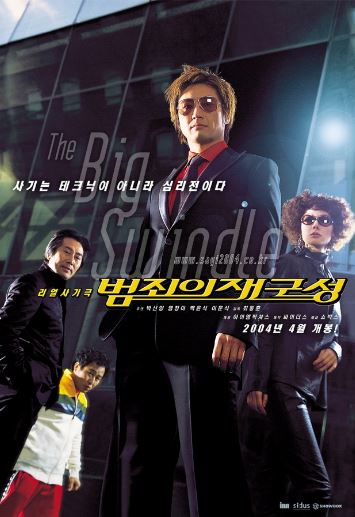The movie The Big Swindle (2004) is about five con artists: Choi Chang-hyuk (played by Park Shin-yang), who has just been released from prison a month after serving time for fraud; the master conman “Mr. Kim” (Baek Yoon-sik); the loudmouth “Eol-mae” (Lee Moon-sik); “Jebi”; and “Gasoline.” They team up to rob the Bank of Korea. They achieve their goal, but now a fight among them to keep the money remains. After this fight concludes, Park Shin-yang, the ultimate winner, says in the movie’s closing scene:
“You’ve been caught! This person’s greed surpasses common sense.”
Getting up early, organizing your desk, or immersing yourself in a task are things you can do if you set your mind to them. There’s only a choice of doing it or not doing it. If you are given alternatives to choose from, you can rationally evaluate the costs and benefits and pick the best option while being mindful of the pitfalls discussed earlier. But what if no viable alternatives exist? In such cases, you have to create them yourself. The method of thinking to find good alternatives is called strategic thinking.
“Knowing oneself” is the effort to understand oneself. “Knowing the enemy” means understanding others. Strategic thinking begins by looking at both knowing oneself and knowing the enemy. Visually laying out knowing oneself and knowing the enemy gives you the famous SWOT analysis framework. When our strengths, weaknesses, opportunities, and threats are laid out before us, that is SWOT. Through such analysis, we can compensate for weaknesses, avoid threats, maximize opportunities, and enhance strengths to create the best strategy. However, it’s not that simple. While we can define strategic thinking as the process of finding ways to align our strengths with environmental opportunities, finding such methods is not as easy as shopping for goods in a market. Analyzing one’s environment and assessing one’s capabilities requires significant knowledge, which can be acquired through learning. However, matching strengths to opportunities requires imagination and creativity because strategy is about preparing for the future, which inherently includes uncertainty.
The most basic strategy is to rely on one’s strengths. While simply pushing through with one’s power or money is a one-dimensional strategy, it is still a strategy. If you believe your army is larger, choosing a direct confrontation is advantageous. Although fully utilizing our strengths is the lowest level of strategic thinking, it is often underutilized. The next level involves hiding your weaknesses and exploiting the opponent’s weaknesses, which are opportunities. “Defend with principles and win with technical irregularities” means deceiving the opponent by exploiting their weaknesses, such as their greed or arrogance—a common strategy among con artists. The third level of strategy involves fully utilizing the environmental opportunities available, even if they do not directly involve the opponent. Admiral Yi Sun-sin used the currents of Myeongnyang Strait to defeat 333 Japanese ships with just 13 of his own. Charlemagne of the Frankish Empire said, “Let the rocks and trees around me and the birds in the sky become my army.” In Indiana Jones and the Last Crusade, Indiana’s father, Henry Jones, remembers this saying and uses a flock of seagulls to bring down a German plane. In The Cup, a Buddhist monk uses a higher-level strategy that involves changing oneself to utilize one’s strengths.
No matter what strategy you use, the principle of considering what to give up is unavoidable. While strategy is about gaining something, which is relatively visible, it is not easy to see what we need to give up to gain it. That is why it’s essential to consider what to give up first when developing a strategy. Even when relying on the number of your troops in a direct confrontation, sacrifices are inevitable. To lure the enemy to Myeongnyang Strait, bait is needed. To wear leather shoes, you must first control your mind. In life, to choose one thing means giving up many others. Each choice comes with numerous sacrifices. Veteran American golfer Ben Crenshaw stated that attacking the golf course aggressively requires considering the price to be paid. The difference between vision and goals lies not only in specificity but also in whether or not one considers the price. To achieve a goal, you must pay a price, meaning you must give up something to gain something. Getting into college requires time and effort. Starting a business requires investment, meaning you must give up your money and devote your time and effort. Deciding what price you’re willing to pay is itself a strategy. Therefore, the statement “My strategy is simply working hard” makes sense.
The art of giving up also helps in choosing alternatives. Economics predicts that the broader the range of choices, the greater our utility. This is based on the assumption that humans can compare and review all these choices rationally. However, in reality, humans are more likely to make mistakes when faced with too many options. Simplification is an essential virtue in decision-making. Simplifying alternatives means giving up relatively redundant and inferior options, even if it feels wasteful. In daily life, we intuitively try to avoid many alternatives. When buying products, we first narrow them down to two or three brands or types. Although having more choices is considered the best, sometimes less is more, which is the paradox of choice.
The more choices we have, the higher the price we pay. Analyzing them requires time and effort, and the broader the range of choices, the more likely we are to make mistakes. Moreover, we are more likely to regret missing out on better opportunities. The fish that got away always seems bigger. The more we regret the alternatives we had to give up, the greater the opportunity cost. Although we go through complex analysis and evaluation processes for important decisions, we ultimately compress them into a few simple variables and struggle with a handful of options. Malcolm Gladwell, in his book Blink, says, “The best decision-makers are those who know how to block out the less important 98 factors and focus intuitively on the two that matter most.”
Looking at our daily lives, giving up is always a stumbling block due to our greed, but simply giving up can help us discover many strategies. As Park Shin-yang’s character in The Big Swindle states, most cons work because of human greed. Not just cons, but most failures in daily life and arguments with close ones happen because of greed that surpasses common sense. We cannot get as much as our greed desires because of our limited abilities and resources, yet we find it hard to give up. However, if we genuinely want to gain something, we need to consider what we can give up first. Finding what to give up is essential. This strategy is also useful in interpersonal relationships. For instance, even a small gift with sincerity can have a surprising effect, and if you can sacrifice your time and comfort, you can always build a necessary support network around you. This also applies to our daily schedules. Despite having limited areas of influence, we tend to care about too many things. By giving up a few of these concerns, we might live a more proactive life. Stephen Covey defines a proactive person as one who focuses their efforts on areas where they can make a difference. Getting too excited or talking too much about things we cannot influence, or pretending to care about things we don’t intend to, is a waste of time. By giving up superficial or showy concerns, we can use our time more productively and live happier daily lives.
In The Joy of Not Working by Ernie Zelinski, it is stated, “40% of our worries are about events that will never happen, 30% are about events that have already occurred, 22% are about trivial matters, and 4% are about events we cannot change.” This means only 4% of our worries are about real events we can deal with. In other words, 96% of our worries are unnecessary. If we can give up this 96%, we can use our thoughts more efficiently.
The art of giving up is also essential for execution. The Art of War states, “If you are superior to the enemy, you can fight them (敵則能戰之), but if you are inferior, you should avoid them (少則能逃之), and if you are no match, you must avoid the battle (不若則能避之).” Life presents numerous difficult situations. When faced with or anticipating such situations, we must consider the option of giving up, yet we often fail to make such decisions. Persisting in difficult circumstances can lead to more significant problems, causing pain for ourselves and our families. However, society focuses on successful individuals. Regardless of what success means, we try to find the secrets to success from successful people, who unanimously advise us never to give up. But we must remember that more people fail than succeed. Nonetheless, because giving up is emotionally associated with failure, no one easily advises giving up. Giving up can prevent greater difficulties. Many people facing hardships do not take the necessary steps to give up, either due to complacency, recklessness, or laziness, even when they are aware of their predicament. Giving up is also an action, and “giving up” is a crucial part of strategic execution. Giving up on what you’re doing doesn’t mean giving up on your goal. It means preparing for a new attempt or a fresh start.
We have discussed how knowing oneself and knowing the enemy forms the basis of strategic thinking, and that SWOT analysis is a visualization tool for this process. Therefore, we must thoroughly and coldly conduct a SWOT analysis on ourselves. This is an essential process for developing life strategies. If we find that our capabilities are insufficient or the environment too challenging to achieve our goals, we have only two options: either upgrade our capabilities by investing time and money or strive to find new goals. Here, capabilities refer to what we now call core competencies. We might call this strategy focusing or differentiation. Focusing is looking at it from an internal perspective, while differentiation is from an external perspective, both implying the same thing. Now, we must consider what to give up based on priorities aside from our core competencies. Perhaps only our mothers love completely perfect people. Although it might seem that highly skilled people are more popular, the opposite is often true. Living together implies focusing on one’s core competencies and leaving other areas to others, utilizing their strengths.
So, what are core competencies? According to Gary Hamel and C. K. Prahalad of the University of Michigan Business School, a company’s core competencies must meet four conditions: they must create value, be differentiated, be expandable, and be difficult to copy. We can apply these criteria to individuals. True core competencies for individuals are not just about being better than others but also about creating value, being hard to imitate, and being applicable in different fields. Beyond expertise in one’s field, one must possess rational thinking, an understanding of the world, and the wisdom to work with others to demonstrate their abilities in different areas. Therefore, in life, what we must choose are the core competencies needed to achieve our goals and the networks we work within. What we must give up are the costs we willingly pay to gain these.
“Strategy here is such a tough choice. When you attack on this course, you know you’ll eventually pay a price.” ~ Ben Crenshaw


답글 남기기